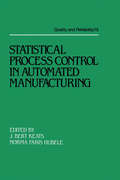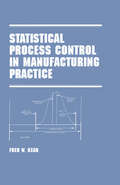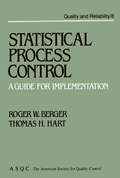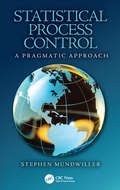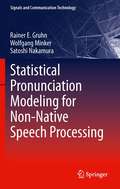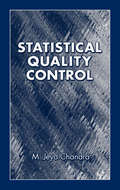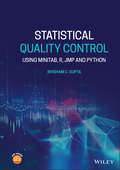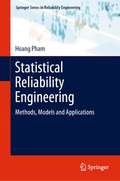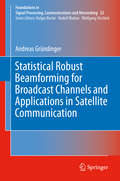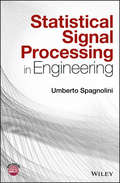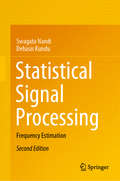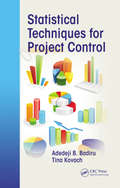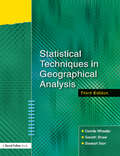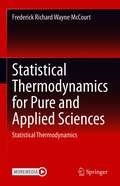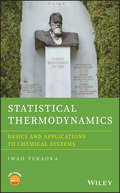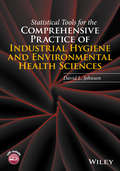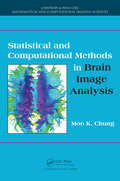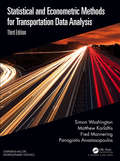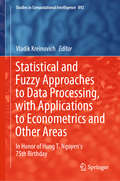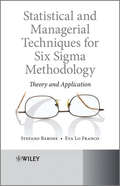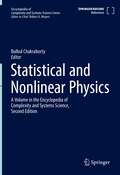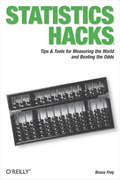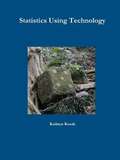- Table View
- List View
Statistical Process Control in Automated Manufacturing
by Bert KeatsThis book provides an introduction to statistical process control in automated manufacturing and suggests implementation strategies. It focuses on time series applications in statistical process control and explores the role of knowledge-based systems in process control.
Statistical Process Control in Manufacturing Practice
by Fred W. KearEmphasizing the importance of understanding and reducing process variation to achieve quality manufacturing performance, this work establishes how statistical process control (SPC) provides powerful tools for measuring and regulating manufacturing processes. It presents information derived from time-tested applications of SPC techniques at on-site process situations in manufacturing. It is designed to assist manufacturing organizations in explaining and implementing successful SPC programmes.
Statistical Process Control: A Guide for Implementation (Quality And Reliability Ser. #8)
by Roger W. Berger Thomas H. HartThis guide aims to strip away the mystery surrounding statistical process control and to present its concepts and principles in as simple and straightforward a manner as possible. It is directed primarily at American business managers.
Statistical Process Control: A Pragmatic Approach (Continuous Improvement Series)
by Stephen MundwillerPeople with minimal math skills, and even those with advanced math skills, have difficulty grasping the intuitive concepts behind Statistical Process Control (SPC). Many practitioners do not understand the concepts behind Control Charts, the differences of out of control and out of specification, and the process variation on Control Charts. This book will explain these concepts by using a simple methodology that will bring a much greater level of understanding to those that use it by providing a detailed description of the method, using common language, real-world examples to illustrate the concept, and instructions on easy implementation.
Statistical Process Monitoring and Optimization (Statistics: A Series of Textbooks and Monographs)
by G. Geoffrey Vining Sung H. ParkDemonstrates ways to track industrial processes and performance, integrating related areas such as engineering process control, statistical reasoning in TQM, robust parameter design, control charts, multivariate process monitoring, capability indices, experimental design, empirical model building, and process optimization. The book covers a range o
Statistical Pronunciation Modeling for Non-Native Speech Processing
by Wolfgang Minker Rainer E. Gruhn Satoshi NakamuraIn this work, the authors present a fully statistical approach to model non--native speakers' pronunciation. Second-language speakers pronounce words in multiple different ways compared to the native speakers. Those deviations, may it be phoneme substitutions, deletions or insertions, can be modelled automatically with the new method presented here. The methods is based on a discrete hidden Markov model as a word pronunciation model, initialized on a standard pronunciation dictionary. The implementation and functionality of the methodology has been proven and verified with a test set of non-native English in the regarding accent. The book is written for researchers with a professional interest in phonetics and automatic speech and speaker recognition.
Statistical Quality Control
by M. Jeya ChandraIt has recently become apparent that "quality" is quickly becoming the single most important factor for success and growth in business. Companies achieving higher quality in their products through effective quality improvement programs enjoy a significant competitive advantage. It is, therefore, essential for engineers responsible for design, devel
Statistical Quality Control: Using MINITAB, R, JMP and Python
by Bhisham C. GuptaSTATISTICAL QUALITY CONTROL Provides a basic understanding of statistical quality control (SQC) and demonstrates how to apply the techniques of SQC to improve the quality of products in various sectorsThis book introduces Statistical Quality Control and the elements of Six Sigma Methodology, illustrating the widespread applications that both have for a multitude of areas, including manufacturing, finance, transportation, and more. It places emphasis on both the theory and application of various SQC techniques and offers a large number of examples using data encountered in real life situations to support each theoretical concept.Statistical Quality Control: Using MINITAB, R, JMP and Python begins with a brief discussion of the different types of data encountered in various fields of statistical applications and introduces graphical and numerical tools needed to conduct preliminary analysis of the data. It then discusses the basic concept of statistical quality control (SQC) and Six Sigma Methodology and examines the different types of sampling methods encountered when sampling schemes are used to study certain populations. The book also covers Phase 1 Control Charts for variables and attributes; Phase II Control Charts to detect small shifts; the various types of Process Capability Indices (CPI); certain aspects of Measurement System Analysis (MSA); various aspects of PRE-control; and more. This helpful guide alsoFocuses on the learning and understanding of statistical quality control for second and third year undergraduates and practitioners in the fieldDiscusses aspects of Six Sigma MethodologyTeaches readers to use MINITAB, R, JMP and Python to create and analyze chartsRequires no previous knowledge of statistical theoryIs supplemented by an instructor-only book companion site featuring data sets and a solutions manual to all problems, as well as a student book companion site that includes data sets and a solutions manual to all odd-numbered problemsStatistical Quality Control: Using MINITAB, R, JMP and Python is an excellent book for students studying engineering, statistics, management studies, and other related fields and who are interested in learning various techniques of statistical quality control. It also serves as a desk reference for practitioners who work to improve quality in various sectors, such as manufacturing, service, transportation, medical, oil, and financial institutions. It‘s also useful for those who use Six Sigma techniques to improve the quality of products in such areas.
Statistical Reliability Engineering: Methods, Models and Applications (Springer Series in Reliability Engineering)
by Hoang PhamThis book presents the state-of-the-art methodology and detailed analytical models and methods used to assess the reliability of complex systems and related applications in statistical reliability engineering. It is a textbook based mainly on the author’s recent research and publications as well as experience of over 30 years in this field. The book covers a wide range of methods and models in reliability, and their applications, including: statistical methods and model selection for machine learning; models for maintenance and software reliability; statistical reliability estimation of complex systems; and statistical reliability analysis of k out of n systems, standby systems and repairable systems. Offering numerous examples and solved problems within each chapter, this comprehensive text provides an introduction to reliability engineering graduate students, a reference for data scientists and reliability engineers, and a thorough guide for researchers and instructors in the field.
Statistical Robust Beamforming for Broadcast Channels and Applications in Satellite Communication (Foundations in Signal Processing, Communications and Networking #22)
by Andreas GründingerThis book investigates adaptive physical-layer beamforming and resource allocation that ensure reliable data transmission in the multi-antenna broadcast channel. The book provides an overview of robust optimization techniques and modelling approximations to deal with stochastic performance metrics. One key contribution of the book is a closed-form description of the achievable rates with unlimited transmit power for a rank-one channel error model. Additionally, the book provides a concise duality framework to transform mean square error (MSE) based beamformer designs, e.g., quality of service and balancing optimizations, into equivalent uplink filter designs. For the algorithmic solution, the book analyses the following paradigm: transmission to receivers with large MSE targets (low demands) is switched off if the transmit power is low. The book also studies chance constrained optimizations for limiting the outage probability. In this context, the book provides two novel conservative outage probability approximations, that result in convex beamformer optimizations. To compensate for the remaining inaccuracy, the book introduces a post-processing power allocation. Finally, the book applies the introduced beamformer designs for SatCom, where interference from neighboring spotbeams and channel fading are the main limitations.
Statistical Signal Processing in Engineering
by Umberto SpagnoliniA problem-solving approach to statistical signal processing for practicing engineers, technicians, and graduate students This book takes a pragmatic approach in solving a set of common problems engineers and technicians encounter when processing signals. In writing it, the author drew on his vast theoretical and practical experience in the field to provide a quick-solution manual for technicians and engineers, offering field-tested solutions to most problems engineers can encounter. At the same time, the book delineates the basic concepts and applied mathematics underlying each solution so that readers can go deeper into the theory to gain a better idea of the solution’s limitations and potential pitfalls, and thus tailor the best solution for the specific engineering application. Uniquely, Statistical Signal Processing in Engineering can also function as a textbook for engineering graduates and post-graduates. Dr. Spagnolini, who has had a quarter of a century of experience teaching graduate-level courses in digital and statistical signal processing methods, provides a detailed axiomatic presentation of the conceptual and mathematical foundations of statistical signal processing that will challenge students’ analytical skills and motivate them to develop new applications on their own, or better understand the motivation underlining the existing solutions. Throughout the book, some real-world examples demonstrate how powerful a tool statistical signal processing is in practice across a wide range of applications. Takes an interdisciplinary approach, integrating basic concepts and tools for statistical signal processing Informed by its author’s vast experience as both a practitioner and teacher Offers a hands-on approach to solving problems in statistical signal processing Covers a broad range of applications, including communication systems, machine learning, wavefield and array processing, remote sensing, image filtering and distributed computations Features numerous real-world examples from a wide range of applications showing the mathematical concepts involved in practice Includes MATLAB code of many of the experiments in the book Statistical Signal Processing in Engineering is an indispensable working resource for electrical engineers, especially those working in the information and communication technology (ICT) industry. It is also an ideal text for engineering students at large, applied mathematics post-graduates and advanced undergraduates in electrical engineering, applied statistics, and pure mathematics, studying statistical signal processing.
Statistical Signal Processing: Frequency Estimation (Springerbriefs In Statistics Ser.)
by Debasis Kundu Swagata NandiThis book introduces readers to various signal processing models that have been used in analyzing periodic data, and discusses the statistical and computational methods involved. Signal processing can broadly be considered to be the recovery of information from physical observations. The received signals are usually disturbed by thermal, electrical, atmospheric or intentional interferences, and due to their random nature, statistical techniques play an important role in their analysis. Statistics is also used in the formulation of appropriate models to describe the behavior of systems, the development of appropriate techniques for estimation of model parameters and the assessment of the model performances. Analyzing different real-world data sets to illustrate how different models can be used in practice, and highlighting open problems for future research, the book is a valuable resource for senior undergraduate and graduate students specializing in mathematics or statistics.
Statistical Techniques for Project Control (Systems Innovation Book Series)
by Adedeji B. Badiru Tina AgustiadyWinner of the IIE Book of the Month for June 2012A project can be simple or complex. In each case, proven project management processes must be followed. In all cases of project management implementation, control must be exercised in order to assure that project objectives are achieved. Statistical Techniques for Project Control seamlessly integrate
Statistical Techniques in Geographical Analysis
by Gareth Shaw Stewart Barr Dennis WheelerThis volume includes changes in the switch from DOS-based to Windows-based, menu-driven forms of SPSS and MINITAB is the most important. The other change shows availability of data in digital form from websites or via CD-ROMs. The book is useful for teachers and students.
Statistical Thermodynamics for Pure and Applied Sciences: Statistical Thermodynamics
by Frederick Richard McCourtThis textbook concerns thermal properties of bulk matter and is aimed at advanced undergraduate or first-year graduate students in a range of programs in science or engineering. It provides an intermediate level presentation of statistical thermodynamics for students in the physical sciences (chemistry, nanosciences, physics) or related areas of applied science/engineering (chemical engineering, materials science, nanotechnology engineering), as they are areas in which statistical mechanical concepts play important roles. The book enables students to utilize microscopic concepts to achieve a better understanding of macroscopic phenomena and to be able to apply these concepts to the types of sub-macroscopic systems encountered in areas of nanoscience and nanotechnology.
Statistical Thermodynamics: An Engineering Approach
by John W. DailyStatistical Thermodynamics: An Engineering Approach covers in a practical, readily understandable manner the underlying meaning of entropy, temperature and other thermodynamic concepts, the foundations of quantum mechanics, and the physical basis of gas, liquid and solid phase properties. It presents simply the relationship between macroscopic and microscopic thermodynamics. In addition, the molecular basis of transport phenomena and chemical kinetics are explored as are basic concepts in spectroscopy. Modern computational tools for solving thermodynamic problems are explored, and the student is assured that he or she will gain knowledge of practical usefulness. This essential text is suitable for mechanical or aerospace engineering graduate students who have a strong background in engineering thermodynamics, those entering advanced fields such as combustion, high temperature gas dynamics, environmental sciences, or materials processing and those who wish to build a background for understanding advanced experimental diagnostic techniques in these or similar fields.
Statistical Thermodynamics: Basics and Applications to Chemical Systems
by Iwao TeraokaThis textbook introduces chemistry and chemical engineering students to molecular descriptions of thermodynamics, chemical systems, and biomolecules. Equips students with the ability to apply the method to their own systems, as today's research is microscopic and molecular and articles are written in that language Provides ample illustrations and tables to describe rather difficult concepts Makes use of plots (charts) to help students understand the mathematics necessary for the contents Includes practice problems and answers
Statistical Tools for the Comprehensive Practice of Industrial Hygiene and Environmental Health Sciences
by David L. JohnsonReviews and reinforces concepts and techniques typical of a first statistics course with additional techniques useful to the IH/EHS practitioner. Includes both parametric and non-parametric techniques described and illustrated in a worker health and environmental protection practice context Illustrated through numerous examples presented in the context of IH/EHS field practice and research, using the statistical analysis tools available in Excel® wherever possible Emphasizes the application of statistical tools to IH/EHS-type data in order to answer IH/EHS-relevant questions Includes an instructor’s manual that follows in parallel with the textbook, including PowerPoints to help prepare lectures and answers in the text as for the Exercises section of each chapter.
Statistical and Computational Methods in Brain Image Analysis (Chapman & Hall/CRC Mathematical and Computational Imaging Sciences Series)
by Moo K. ChungThe massive amount of nonstandard high-dimensional brain imaging data being generated is often difficult to analyze using current techniques. This challenge in brain image analysis requires new computational approaches and solutions. But none of the research papers or books in the field describe the quantitative techniques with detailed illustratio
Statistical and Econometric Methods for Transportation Data Analysis (Chapman & Hall/CRC Interdisciplinary Statistics)
by Simon Washington Matthew G. Karlaftis Fred Mannering Panagiotis AnastasopoulosPraise for the Second Edition: The second edition introduces an especially broad set of statistical methods … As a lecturer in both transportation and marketing research, I find this book an excellent textbook for advanced undergraduate, Master’s and Ph.D. students, covering topics from simple descriptive statistics to complex Bayesian models. … It is one of the few books that cover an extensive set of statistical methods needed for data analysis in transportation. The book offers a wealth of examples from the transportation field. —The American Statistician Statistical and Econometric Methods for Transportation Data Analysis, Third Edition offers an expansion over the first and second editions in response to the recent methodological advancements in the fields of econometrics and statistics and to provide an increasing range of examples and corresponding data sets. It describes and illustrates some of the statistical and econometric tools commonly used in transportation data analysis. It provides a wide breadth of examples and case studies, covering applications in various aspects of transportation planning, engineering, safety, and economics. Ample analytical rigor is provided in each chapter so that fundamental concepts and principles are clear and numerous references are provided for those seeking additional technical details and applications. New to the Third Edition Updated references and improved examples throughout. New sections on random parameters linear regression and ordered probability models including the hierarchical ordered probit model. A new section on random parameters models with heterogeneity in the means and variances of parameter estimates. Multiple new sections on correlated random parameters and correlated grouped random parameters in probit, logit and hazard-based models. A new section discussing the practical aspects of random parameters model estimation. A new chapter on Latent Class Models. A new chapter on Bivariate and Multivariate Dependent Variable Models. Statistical and Econometric Methods for Transportation Data Analysis, Third Edition can serve as a textbook for advanced undergraduate, Masters, and Ph.D. students in transportation-related disciplines including engineering, economics, urban and regional planning, and sociology. The book also serves as a technical reference for researchers and practitioners wishing to examine and understand a broad range of statistical and econometric tools required to study transportation problems.
Statistical and Fuzzy Approaches to Data Processing, with Applications to Econometrics and Other Areas: In Honor of Hung T. Nguyen's 75th Birthday (Studies in Computational Intelligence #892)
by Vladik KreinovichMainly focusing on processing uncertainty, this book presents state-of-the-art techniques and demonstrates their use in applications to econometrics and other areas. Processing uncertainty is essential, considering that computers – which help us understand real-life processes and make better decisions based on that understanding – get their information from measurements or from expert estimates, neither of which is ever 100% accurate. Measurement uncertainty is usually described using probabilistic techniques, while uncertainty in expert estimates is often described using fuzzy techniques. Therefore, it is important to master both techniques for processing data. This book is highly recommended for researchers and students interested in the latest results and challenges in uncertainty, as well as practitioners who want to learn how to use the corresponding state-of-the-art techniques.
Statistical and Managerial Techniques for Six Sigma Methodology: Theory and Application
by Stefano Barone Eva Lo FrancoSix Sigma methodology is a business management strategy which seeks to improve the quality of process output by identifying and removing the causes of errors and minimizing variability in manufacturing and business processes. This book examines the Six Sigma methodology through illustrating the most widespread tools and techniques involved in Six Sigma application. Both managerial and statistical aspects are analysed allowing the reader to apply these tools in the field. Furthermore, the book offers insight on variation and risk management and focuses on the structure and organizational aspects of Six Sigma projects. Key features: • Presents both statistical and managerial aspects of Six Sigma, covering both basic and more advanced statistical techniques. • Provides clear examples and case studies to illustrate the concepts and methodologies used in Six Sigma. • Written by experienced authors in the field. This textbook is ideal for graduates studying Six Sigma for Black Belt and Green Belt qualifications as well as for engineering and quality management courses. Business consultants and consultancy firms implementing Six Sigma will also benefit from this book.
Statistical and Nonlinear Physics (Encyclopedia of Complexity and Systems Science Series)
by Bulbul ChakrabortyThis volume of the Encyclopedia of Complexity and Systems Science, Second Edition, focuses on current challenges in the field from materials and mechanics to applications of statistical and nonlinear physics in the life sciences. Challenges today are mostly in the realm of non-equilibrium systems, although certain equilibrium systems also present serious hurdles. Where possible, pairwise articles focus on a single topic, one from a theoretical perspective and the other from an experimental one, providing valuable insights. In other cases, theorists and experimentalists have collaborated on a single article. Coverage includes both quantum and classical systems, and emphasizes 1) mature fields that are not covered in the current specialist literature, (2) topics that fall through the cracks in disciplinary journals/books, or (3) developing areas where the knowledge base is large and robust and upon which future developments will depend. The result is an invaluable resource for condensed matter physicists, material scientists, engineers and life scientists.
Statistics Hacks: Tips & Tools for Measuring the World and Beating the Odds
by Bruce FreyWant to calculate the probability that an event will happen? Be able to spot fake data? Prove beyond doubt whether one thing causes another? Or learn to be a better gambler? You can do that and much more with 75 practical and fun hacks packed into Statistics Hacks. These cool tips, tricks, and mind-boggling solutions from the world of statistics, measurement, and research methods will not only amaze and entertain you, but will give you an advantage in several real-world situations-including business.This book is ideal for anyone who likes puzzles, brainteasers, games, gambling, magic tricks, and those who want to apply math and science to everyday circumstances. Several hacks in the first chapter alone-such as the "central limit theorem,", which allows you to know everything by knowing just a little-serve as sound approaches for marketing and other business objectives. Using the tools of inferential statistics, you can understand the way probability works, discover relationships, predict events with uncanny accuracy, and even make a little money with a well-placed wager here and there.Statistics Hacks presents useful techniques from statistics, educational and psychological measurement, and experimental research to help you solve a variety of problems in business, games, and life. You'll learn how to:Play smart when you play Texas Hold 'Em, blackjack, roulette, dice games, or even the lotteryDesign your own winnable bar bets to make money and amaze your friendsPredict the outcomes of baseball games, know when to "go for two" in football, and anticipate the winners of other sporting events with surprising accuracyDemystify amazing coincidences and distinguish the truly random from the only seemingly random--even keep your iPod's "random" shuffle honestSpot fraudulent data, detect plagiarism, and break codesHow to isolate the effects of observation on the thing observedWhether you're a statistics enthusiast who does calculations in your sleep or a civilian who is entertained by clever solutions to interesting problems, Statistics Hacks has tools to give you an edge over the world's slim odds.
Statistics Using Technology
by Kathryn KozakThis is a statistics textbook to be used in an introductory statistics class. This book uses technology to calculate probabilities. The approach to this textbook is to ask people to interpret statistics and think statistically.
